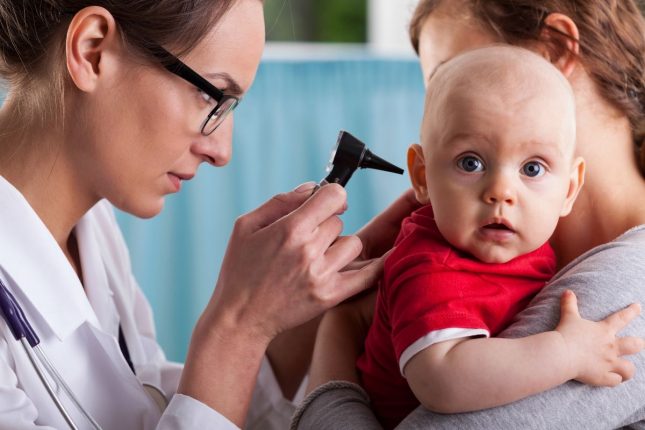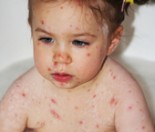This article explains the types of ear infections in toddlers and young children, the signs and symptoms to look out for and the treatment for ear infections.
What is an ear infection?
An ear infection is one of the most common of childhood diseases. Around one in six children will suffer from an ear infection in their first year of life. Such infections are particularly common in children because the Eustachian tube (pronounced “you-station” – the tube that connects the middle ear to the back of the throat) is narrow, which can cause poor drainage, blockage and, in turn, infection.
Your child’s immune system is also less developed and children are regularly exposed to new viruses and bacteria. Some children suffer repeated ear infections.
There are two types of ear infection:
- Middle ear infections (otitis media) occur in the space behind the eardrum. The middle ear is a warm, sealed place that makes for an ideal environment for viruses and bacteria to grow. Middle ear infections can be caused by a virus or infection that has spread from the throat via the Eustachian tube and often follow on from a cold or chest infection. The incidence of otitis media in children decreases after age eight, as their eustachian tube grows in size.
- Outer ear infections (otitis externa) happen when a bacteria or fungal infection has infected the canal. This can be caused by a foreign object, eczema, or can occur in a child who swims a lot, pokes their ears or has been excessively cleaning the ear.
What are the signs and symptoms of ear infections?
Symptoms of a middle ear infection include:
- A middle ear infection will often start with cold-like symptoms
- Earache and fever
- Crying, in pain and feeling really miserable
- Your child complaining of a headache
- Flushed cheeks
- Your child losing their appetite
- Suffering from vomiting or diarrhoea
- Discharge from the ear – if the eardrum has burst there may be a mixture of blood and pus
Symptoms of an outer ear infection include:
- Discharge from the ear
- Your child rubbing or pulling their ear continuously
- Earache or an itching ear
- The ear may appear red and feel tender
What is the treatment for earache?
An ear infection needs to be checked out by your doctor, who will examine your child’s ear with an auriscope (a device to see inside the ear).
Treatment of a middle ear infection involves:
- pain relief
- treatment of fever
- antibiotics to fight infection (if caused by bacteria) – some people debate the necessity of taking antibiotics, with many children getting better within a couple of days without taking medicine
- the doctor may prescribe decongestants to help the middle ear drain.
Treatment of an outer ear infection will include:
- eardrops to clear infection
- any foreign object or abscess will be dealt with
- your child will also need to stop swimming until the infection clears
- try to keep their ears as dry as possible when washing their hair.
Repeated ear infections may mean your doctor will refer your child to an ear, nose and throat specialist for further investigation.
Risks & complications of ear infection
Repeated middle ear infections may sometimes cause the continual presence of sticky fluid in the middle ear. This is commonly known as glue ear and can cause hearing loss and a feeling of fullness deep in the ear.
Glue ear needs to be treated promptly as delayed treatment can lead to delay in your child learning to speak and, if left untreated, can lead to permanent deafness.
However, it is often painless and may go unnoticed by parents. A child suffering from glue ear may sleep with their mouth open and snore, or speak with a nasal twang.
Commonly glue ear is treated by an operation under general anaesthetic in which tiny plastic tubes, called grommets, are inserted into the eardrum. Grommets work by equalising pressure on both sides of the eardrum to help keep the ear dry. The grommets will fall out naturally after several months and the hole in the eardrum will heal over. Occasionally a grommet will need to be re-inserted if fluid builds up again in the ear.
Sometimes chronic ear infections will cause your doctor to suggest your child’s tonsils should be removed.
What can I do about ear infections?
If you suspect your child has an ear infection, then take them to see a doctor quickly. In the interim, pain can be treated with a pain relief medicine such as paracetamol syrup; making sure you check the dose for your child’s age group on the bottle.
Keep your child as comfortable as possible:
- Use a warm flannel or wheatpack as a compress to hold against the ear.
- Holding your child in an upright position may also help alleviate pain.
- Any child who is prone to ear infections should be encouraged to drink from a cup, rather than a bottle (lying down while drinking a bottle can cause milk to trickle from the back of the throat to the eustachian tube).
- Avoid using ear buds or anything else to clean the ear. Any discharge can be wiped clear from the outside of the ear.
- Give plenty of fluids and encourage your child to rest
- Keep the ears dry
- If your child has trouble hearing or seems inattentive at school, arrange to have a hearing test done with an audiologist
Now that you know more about ear infections, you may want to arm yourself with more expert health advice, see our Common childhood illnesses section.






